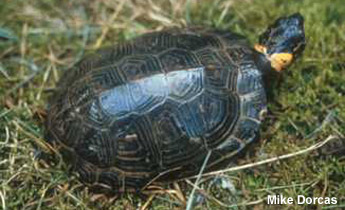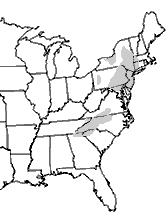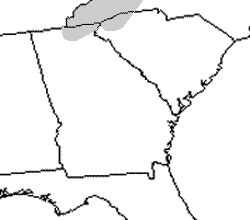Bog Turtle (Glyptemys muhlenbergii)



Photos by J.D. Willson unless otherwise noted
| Description: The bog turtle is the smallest North American turtle and it rarely exceeds 4 in (11 cm) in size (3-3.5 in, 7.5 – 9 cm on average). It is usually identified by its small size and orange/yellow patches on the sides of its head and neck region. Its carapace is brown/black and is often sculptured with obvious growth rings on each scute. Its plastron is cream colored with black patches and lacks hinges. Males tend to have much longer and thicker tails than females and males have a slightly concave plastron.
Range and Habitat: Bog turtles are found in scattered populations along the Appalachian Mountains in the eastern U.S., with centers of abundance in the northeast (New York and Pennsylvania) and the Blue Ridge Mountains of the Southeast. In our region they are most common in North Carolina but their range extends into the mountains of northeastern Georgia and northwestern South Carolina. The prefer cool, clear, shallow, slow-moving, muddy bottomed streams that run through meadows, in swamps, and in sphagnum bogs (as their name suggests). In Georgia, they inhabit mountain bogs, which are unique wetland habitats that only occur in the Blue Ridge Mountains. Unfortunately, these mountain bogs, like much of their habitat, are quickly disappearing mainly due to human development, such as the draining and filling of their wetlands. Pollution and invasive plant species have also had a negative impact on their environment. Ironically, because they require open habitats, cattle grazing and fire are often beneficial for this species. Habits: Bog turtles are diurnal and spend the day foraging in the water for plants and animals (e.g. various insects, invertebrates and seeds). They breed after emerging from hibernation in late spring/early summer. Females lay from 2-5 eggs in June/July in a nest situated in a sunny area of a bog and is usually constructed from sphagnum moss. Eggs hatch in about 7-8 weeks in late summer/fall. It takes about 5-8 years for these turtles to reach sexual maturity. Bog turtles have been known to hibernate in the deep mud bottoms of bogs, but do not start doing so until they are 2-3 years old. Their small size makes them vulnerable to predation by animals such as raccoons and skunks, which also prey on their eggs and hatchlings. Conservation Status: The bog turtle is state and federally listed as threatened and is a protected species. In 2003, it was listed by the Turtle Conservation Fund as one of the 25 most endangered turtles in the world. Habitat loss and fragmentation is the main threat to this species. In the past this species was heavily collected for the pet trade and over collection is still a major concern in the conservation of this species. It is illegal to possess bog turtles without a permit. Account Author: Justin Oguni, University of Georgia – edited by J.D. Willson |
